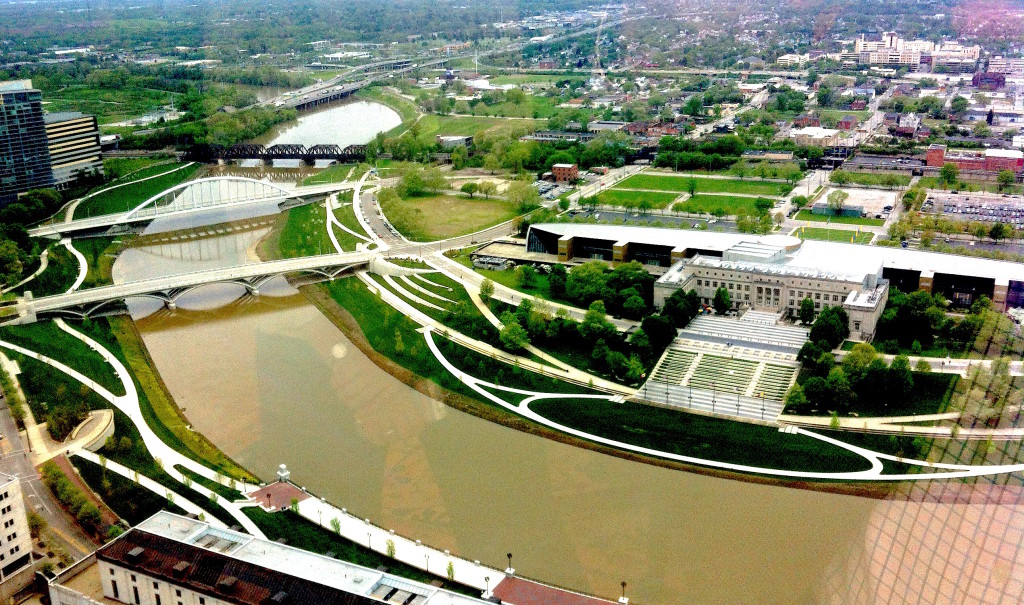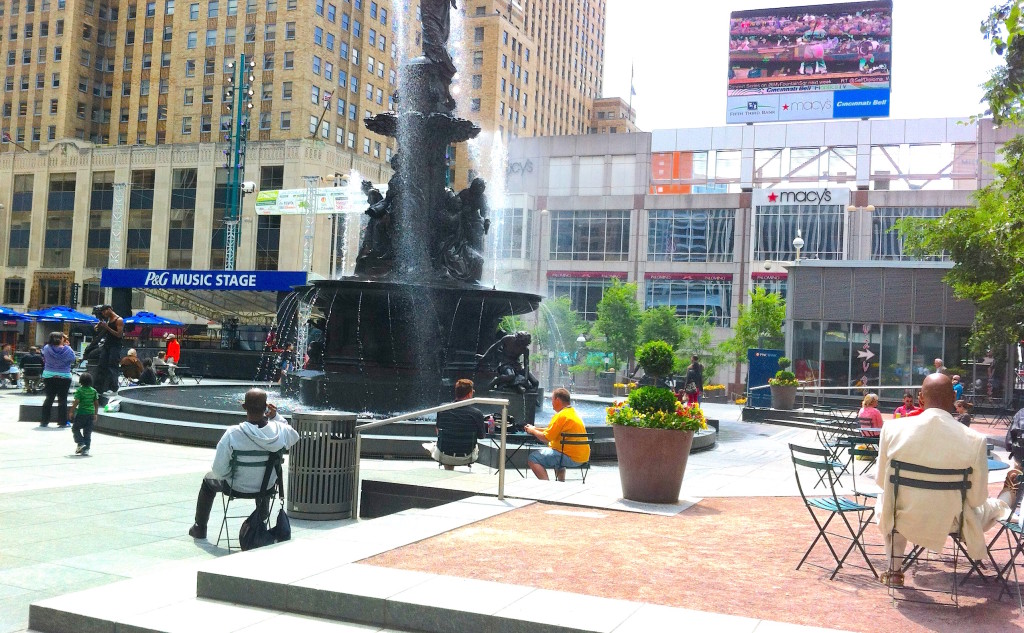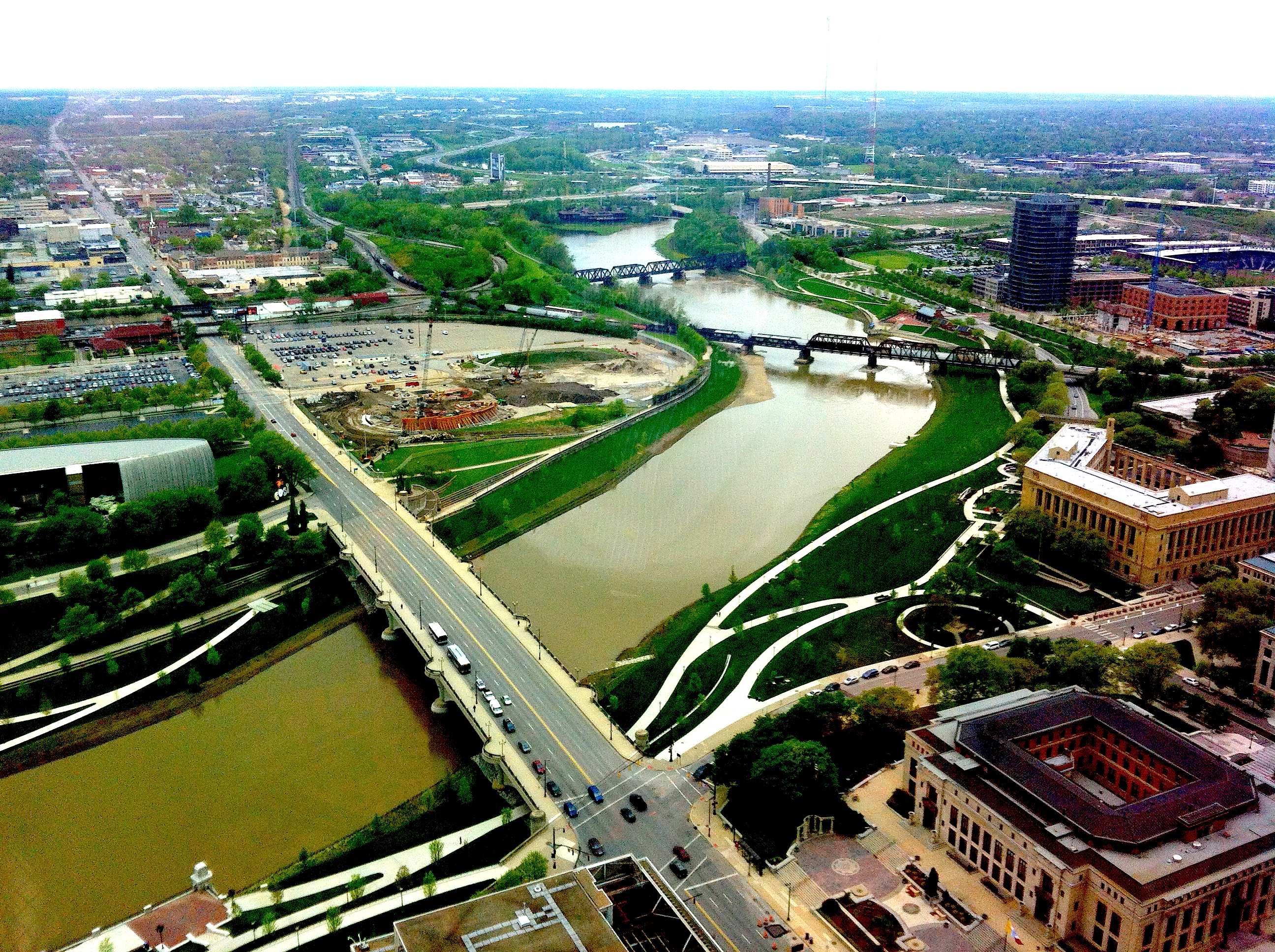
COLUMBUS, OH — In the year of Trump it’s plain that the United States is entering a new and reckless age. Our federal lawmakers neglect their constitutional duties to legislate in the public interest. Ideology and inflexibility, the gravest threats to a democracy, are elevated as virtues on the political right and political left. Random massacres occur with weekly frequency. Fear and distrust and racism and hate have been unleashed as mainstream attitudes.
Where are the places that inspire order? Where are the places that effectively manage their affairs with a goal of adding to civility and the common good?
Perhaps it is surprising, but a good number of American cities answer those questions. As readers of ModeShift know, some of my time each year is taken up with reporting real estate articles for The New York Times. Generally the narrative that emerges from details about construction costs and square feet amounts to a profile of the cities that I visit.
What I find, from New York to Boston to San Francisco, Grand Rapids to Louisville, Buffalo to Cleveland to Toledo to Cincinnati, is that many of America’s big cities, and a good number of its mid-size cities, are thriving. Largely without the help of the federal government and state Legislatures, elected leaders are collaborating with business executives and civic organizations to invest in ways that respond intelligently to the market conditions of this century.
In each city the formula for progress differs in the specifics. Buffalo reorganized itself around a university medical center and a transit line. Toledo turned to Chinese investors. Cleveland spent $800 million on entertainment and transit infrastructure – two stadiums, the Rock and Roll Hall of Fame, a bus rapid transit route, and moving a commuter rail station — to invite $5 billion in mostly private downtown redevelopment. Sacramento tore down a moribund downtown shopping mall and built a new arena for the NBA Sacramento Kings.
Taken collectively, though, the various development strategies pursued by American cities have some common traits. Excellent elected leadership and pragmatic business collaboration are essential to developing and executing redevelopment ideas that take at least a decade, and often a generation, to complete. Redevelopment plans incorporate one or more of the following ingredients — competent municipal agencies, park construction, improved transit, strengthened schools, public safety, adequate amounts of reasonably priced housing, recruiting innovators and entrepreneurial businesses.
Over the next month or so I’ll be reporting on cities in the South and Midwest – Columbus, Cleveland, and Chattanooga –all of which are doing well. They are following effective redevelopment strategies that are much bolder, and more effective, than anything pursued by most states and certainly by America’s imprudent Congress. The latest report from a city making strong progress in adding value to the lives of its citizens is from Columbus, which I visited early in May.
City leaders and business executives in Ohio’s capital city reached a consensus earlier this century that the formula for encouraging center city development included three unexpected ingredients: more grass, less water, and targeted taxpayer spending.
In May, the Arshot Investment Corporation became the latest developer to embrace the formula. The company announced its plan for Millennial Tower, a 25-story, $90 million, 400,000-square foot mixed-use development that includes 180,000 square feet of office space, 40,000 square feet of retail space, and 100 units of residential apartments. Construction of the tower is scheduled to start early next year on the corner of Rich and Front streets, a short walk from the nine-acre Columbus Commons, completed in 2011, and one block from the city’s magnificent Scioto River shoreline promenade and park, completed last year.

“What happened here is that people chose the future,†said Mayor Andrew J. Ginther, a 41-year-old Democrat who took office in January following eight years on the City Council. “Our business leaders work closely with the public sector. We’ve taken some big steps that worked. It gave the city credibility.â€
A New Tax During the Great Recession
Arguably the most significant campaign, led by former Mayor Michael B. Coleman and the City Council, was to convince Columbus residents in August 2009 to narrowly approve a city income tax increase, from 2 percent to 2.5 percent, during the height of the Great Recession. The added revenue prevented city police, fire, and staff layoffs, and enabled Columbus to begin investing in a downtown reconstruction plan developed in 2002.
The city, Franklin County, and the state spent $63 million from 2011 to 2015 to build three new parks that cost a total of $105 million. The balance was raised from city businesses, most of them affiliated with the Columbus Downtown Development Corporation, which managed the construction.
In 2011, the development corporation finished scraping away the 1.2-million-square-foot Columbus City Center. The nearly empty shopping mall, opened in 1989, was replaced by Columbus Commons, a $25 million expanse of grass, gardens, and a tree-shaded food court inspired by New York City’s Bryant Park.

The same year the city rebuilt its eastern Scioto River shoreline, shrinking a five-lane riverfront boulevard to three lanes, and adding a promenade, a cooling summertime fountain, a colonnade, and restaurants. The renamed Scioto Mile cost $44 million.
Columbus then eyed its listless and muddy Scioto River. In 2013, the development corporation removed the Main Street Dam, which was completed in 1918 to control flooding but also doubled to 600 feet the distance between the river’s east and west banks. With the dam out of the way, and with the help of dredges to remove sediments, the river narrowed to 300 feet, and the city gained 33 acres of once-submerged shoreline that opened as the $36 million Scioto Greenways park last year.
Columbus’ strategy of seeding anticipated private real estate investment with taxpayer funds defied the principles of low-tax, public spending austerity that gripped Ohio’s Legislature and Congress. Its effect, though, has been to replace the cracked asphalt of surface parking lots with nearly $350 million in new and renovated buildings that house thousands of downtown residents, and helped generate 1,000 jobs.
“Our thought was that green space would change how people viewed this part of the city,†said Mr. White. “It did just that.â€
“We knew we needed to build the amenities to attract privately-financed development. That was the formula we thought would work,†added Guy V. Worley, the president and chief executive of the Columbus Downtown Development Corporation, which organizes and manages 250 events annually events there. “We had a lot of help from our major businesses here, which wrote seven- and eight-figure checks. At the same time, the public investment has been substantial.â€

City of New Ideas
With 836,000 residents, Columbus is the largest city in Ohio and the third largest in the Midwest behind Chicago and Indianapolis. Unlike it’s two big Ohio sister cities – Cincinnati and Cleveland – Columbus has grown substantially over the last generation. In 1990 the city’s population was 638,000. Business executives and government leaders cite its long history as the state capital, its central Ohio location, and a huge pool of graduating students from The Ohio State University and other colleges as competitive advantages in sustaining the city’s strong and diversified economy.
Columbus also possesses a distinctive allegiance to big ideas expressed without flamboyance, and to persistence in sticking with them. In 1991, for instance, city engineers discovered that cleaning up tiny traces of chemicals in the dirt behind a maintenance facility would cost $2 million because of national hazardous waste rules. Columbus issued an influential report that asserted such urban cleanups cause enormous expense for little gain. The report, promoted by the city, started a national campaign to change standards and sharply reduce the cost of making urban industrial sites, called “brownfields,†safe for new construction. The brownfield rules, enacted in the mid-1990s, were a signal adjustment in U.S. environmental policy that helped Columbus and other American cities redevelop their waterfronts and central business districts.
Similarly in the late 1990s, Columbus recognized that a 75-acre industrial area and abandoned railyard along the Scioto River, about a mile north of Columbus Commons, was a prime site for a new residential, office, and entertainment district. The city collaborated with Nationwide Realty Investors, an affiliate of Columbus-based Nationwide Mutual Insurance, and turned the area into the $750 million Arena District. The district, now one of the city’s most active areas for work and residences, also hosts the Columbus Blue Jackets of the National Hockey League in the 18,500-seat Nationwide Arena, and the Columbus Clippers, the Triple-A affiliate of the Cleveland Indians, which plays in 10,100-seat Huntington Park.
According to the mayor’s office the Arena District, the Columbus Commons area, and several more projects represent the results of $388 million in public infrastructure investment that generated over $1.99 billion in private investment in Columbus’ downtown. Some 1,600 new jobs have settled into 2.5 million square feet of new office space. The number of people living in the city’s center has increased to 7,500, twice as many as in 2000.
The next target for development, said Mayor Ginther, is Franklinton, one of the city’s oldest neighborhoods across the river from downtown in the 200-acre floodplain along the Scioto’s western bank. Ignored for decades, Franklinton’s turn of the 20th century homes and mid-20th century light industrial buildings are separated by innumerable empty parcels. “You watch what happens there,†said Mr. Ginther. “We’ve got the public investments in place to make that neighborhood really work. Rents already are going up.â€

From one of the top floors of an office building near City Hall, the full measure of those investments unfold along the river. Flowing ribbons of concrete pathways criss-cross deep green lawns on both river banks. The promenade along the Scioto Mile, with its ornamental balustrades and colonnades, beckon strollers enjoying an early spring warming sun. The $65 million Ohio Veterans Memorial and Museum is under construction on a seven-acre site. The Downtown Development Corporation is promoting a site just a block away for a big retail, residential, and office project.
“Water and open space,†said Mr. Worley, the corporation’s chief executive. “If we had not built the Commons and the Scioto greenways nothing would have happened in this part of the city.â€
Read the New York Times version of this article here.
— Keith Schneider


